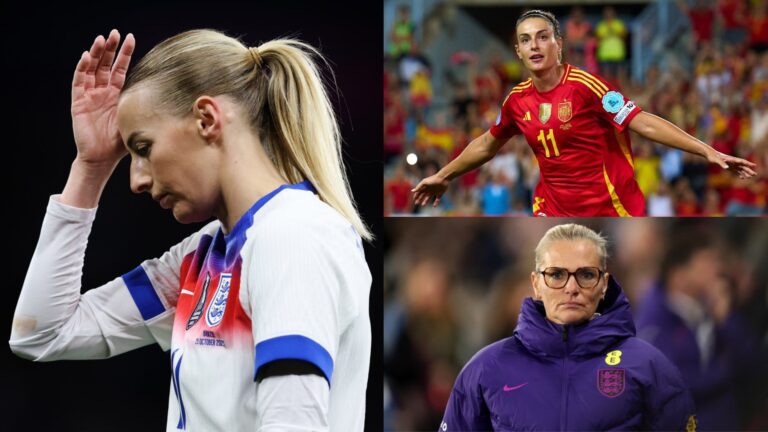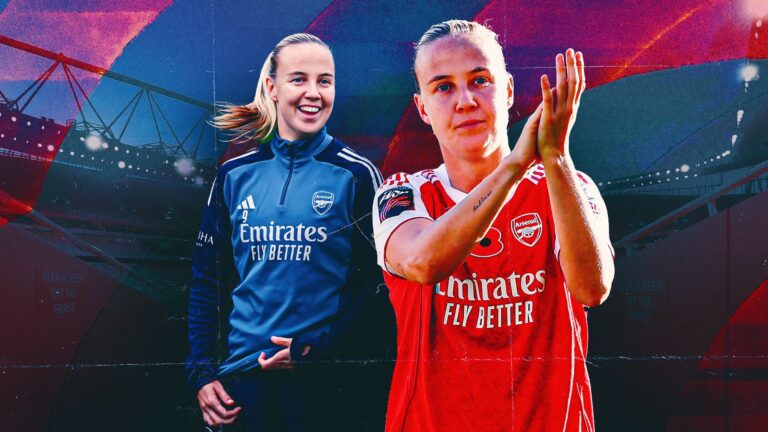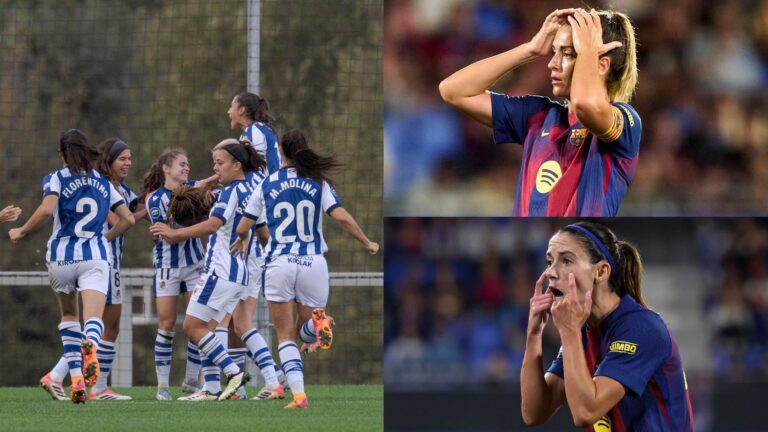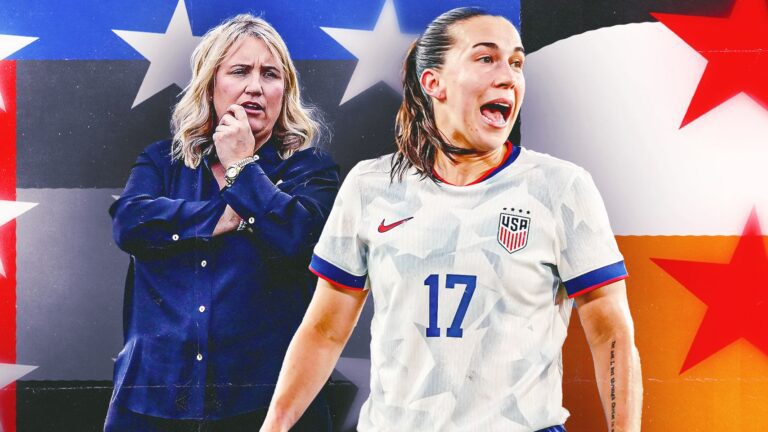Trinity Rodman’s MCL Sprain: A Positive Turn After Alarming Exit
Trinity Rodman, the standout USWNT winger, has faced a new setback with an MCL sprain, but the outcome brings much-needed reassurance for fans and her team alike. Just after her selection to the national squad, this injury highlights her ongoing challenges, yet offers hope for a swift recovery that could see her back in action sooner than anticipated.
Details of the Injury and Immediate Aftermath
During a recent match for the Washington Spirit, Trinity Rodman experienced a painful moment that forced her off the field in distress, raising concerns among supporters. She struggled to bear weight on her right leg, leading to visible emotion as she left the game. Later observations showed her using crutches and a knee brace, sparking worries about a potentially severe issue. However, updates from the team’s leadership provided a more optimistic outlook, suggesting that while she might miss some upcoming NWSL events, the situation isn’t as dire as initially thought.
Coach’s Perspective on Early Recovery Efforts
Washington Spirit’s head coach shared encouraging details about Trinity Rodman‘s condition during a media session. He noted that she’s already begun rehabilitation at the team’s facility and is responding well. “We’re dealing with the best possible outcome under the circumstances,” he explained, emphasizing that although injuries are never ideal, this MCL sprain appears manageable with careful monitoring.
In further comments, the coach highlighted the diagnosis: “It’s a minor MCL issue, and we’re prioritizing her daily progress to ensure proper healing.” This approach underscores the team’s commitment to personalized care, focusing on her rehabilitation without rushing timelines.
Individualized Recovery Strategy
When addressing reporters a couple of days later, the coach elaborated on how the team tailors recovery plans. He pointed out that athletes vary greatly in their needs, stating, “Each individual requires a unique plan based on their history and physical demands.” For Trinity Rodman, this means a step-by-step focus on healing, with adjustments made as she improves, rather than a fixed schedule. The emphasis remains on supporting her full recuperation to avoid future complications.
Implications for USWNT and Washington Spirit’s Season
This development poses challenges for USWNT coach Emma Hayes and the national program, who had high hopes for Trinity Rodman‘s return following her absence due to a persistent back problem from earlier in the year. Despite her time away from April to August, she’d regained her form recently, contributing seven goals in limited playtime, making her absence a significant loss.
Hayes’ Thoughts on Rodman’s Role
Prior to the incident, Hayes expressed enthusiasm about reintegrating Trinity Rodman into the team. She described her as a top-tier talent whose foundational training has been crucial for her health. “It’s thrilling to have her ready to contribute again, especially in a stable condition,” Hayes remarked, reflecting on the importance of her presence after such a long break.
Upcoming Matches and Playoff Positioning
As the Washington Spirit aim for the No. 2 spot in the NWSL playoffs, starting in about three weeks, they’ll need to navigate without their key player for at least part of the run. The team reached the championship last year but fell short against the Orlando Pride. Their next fixture is a high-stakes rematch with those same opponents this weekend, followed by a season-ender against the Utah Royals on November 2, where her potential absence could influence their performance.
Understanding Trinity Rodman’s MCL Sprain
Trinity Rodman, the dynamic forward for the US Women’s National Team and the Washington Spirit, recently faced a scare when she was diagnosed with an MCL sprain. This injury occurred during a hard-fought victory for the Washington Spirit, but thankfully, it wasn’t as severe as it could have been. MCL sprains are common in sports like soccer, where quick changes in direction and physical contact are the norm. For fans and athletes alike, knowing the details of Rodman’s situation can offer insights into injury management and prevention in women’s soccer.
MCL sprains happen when the medial collateral ligament, which stabilizes the inner knee, gets stretched or torn. In Rodman’s case, the injury was caught early, allowing for a quicker recovery path. This highlights the importance of immediate medical attention in professional sports, especially for high-profile players like those on the US Women’s National Team. Keywords such as “Trinity Rodman injury update” and “MCL sprain in soccer” have been trending as supporters seek the latest on her status and how it might affect upcoming matches.
The Details of the Washington Spirit Victory
During the match that led to Rodman’s MCL sprain, the Washington Spirit secured a thrilling win, showcasing the team’s resilience despite the setback. Rodman, known for her speed and agility on the field, was involved in a collision that twisted her knee, prompting her to leave the game early. Medical evaluations post-game confirmed the MCL sprain, but scans revealed no major tears, which was a huge relief for the team and fans. This incident underscores how even in moments of triumph, injuries can pose challenges for athletes in the NWSL and beyond.
Experts note that early detection, as seen with Rodman, often means a shorter recovery time. For instance, players with minor MCL sprains can return to play within weeks, depending on rehabilitation protocols. Rodman’s ability to avoid a more severe injury is a testament to the advancements in sports medicine, including on-field diagnostics and player conditioning programs tailored for women’s soccer.
What Causes MCL Sprains in Soccer Players?
MCL sprains like the one experienced by Trinity Rodman are typically caused by direct impacts or sudden twists. In soccer, this can happen during tackles, falls, or rapid pivots, making it a frequent concern for forwards and midfielders. Factors such as improper footwear, uneven playing surfaces, or fatigue can exacerbate the risk, which is why teams like the Washington Spirit emphasize comprehensive training routines.
To put this in context, consider how Rodman’s role in the US Women’s National Team involves high-intensity sprints and defensive pressures, increasing her exposure to knee injuries. Understanding these causes helps athletes and coaches implement better strategies, blending keywords like “preventing MCL sprain in women’s soccer” naturally into discussions about player safety.
Benefits of Early Diagnosis for Athletes
One of the key benefits of early diagnosis, as in Rodman’s case, is the ability to tailor a recovery plan that minimizes downtime. For professional soccer players, this means potentially returning to the field faster without compromising long-term health. Early intervention can reduce the risk of chronic issues, such as knee instability, and allow for personalized physical therapy that strengthens surrounding muscles.
Additionally, avoiding severe injuries through prompt care can enhance an athlete’s career longevity. Rodman’s situation serves as a positive example, showing how modern sports medicine benefits include advanced imaging techniques and expert consultations, which help in making informed decisions quickly.
Practical Tips for Preventing Knee Injuries in Soccer
If you’re a soccer enthusiast or aspiring player, learning from Trinity Rodman’s MCL sprain can be invaluable. Here are some practical tips to incorporate into your routine:
- Strengthen key muscle groups: Focus on exercises that target the quadriceps, hamstrings, and core to provide better knee support. Squats, lunges, and balance drills can be game-changers for preventing MCL sprains.
- Warm up properly: Always start with dynamic stretches and light jogging to prepare your joints for the demands of soccer. This is especially crucial for women’s soccer players who might face higher injury risks due to differences in training loads.
- Use proper technique: During practices and games, emphasize correct landing and pivoting forms to avoid unnecessary strain on the knees. Coaches can integrate video analysis to help players refine their movements.
- Wear appropriate gear: Invest in high-quality cleats with good ankle support and consider knee braces if you have a history of injuries. This tip aligns with broader efforts in the US Women’s National Team to promote gear that enhances performance and safety.
- Incorporate rest and recovery: Listen to your body and include rest days in your schedule. Techniques like foam rolling and ice baths can aid in reducing inflammation, much like what Rodman might be using in her rehabilitation.
These tips not only help in avoiding MCL sprains but also boost overall athletic performance, making them essential for anyone involved in competitive soccer.
Case Studies of Similar Injuries in Professional Sports
Examining case studies from other athletes provides deeper insights into MCL sprains. For example, in the world of women’s soccer, players like Alex Morgan have dealt with knee issues, highlighting how timely interventions led to successful comebacks. In Rodman’s scenario, the parallels are clear: quick diagnosis allowed her to sidestep surgery and focus on rehab, similar to how other NWSL stars have managed their injuries.
Another case involves basketball players, where MCL sprains are also prevalent due to jumping and landing dynamics. These studies show that with dedicated physiotherapy and gradual return-to-play protocols, athletes can regain full strength without long-term setbacks. Rodman’s experience fits into this narrative, emphasizing the evolving landscape of sports injury recovery.
First-Hand Experiences from Athletes
Drawing from first-hand experiences, many players share stories of overcoming MCL sprains through resilience and support systems. While we don’t have direct quotes from Trinity Rodman, reports from her teammates and coaches paint a picture of a determined athlete. For instance, in interviews, Washington Spirit players often discuss the mental challenges of injuries, stressing the importance of team support and mental health resources.
One athlete from the US Women’s National Team previously noted how visualizing recovery helped them return stronger, a strategy Rodman might be employing. These personal accounts add a human element, reminding readers that behind every injury statistic is an individual pushing through adversity.
By learning from these experiences, fans and players can appreciate the dedication required in professional sports, further integrating keywords like “Trinity Rodman recovery journey” into ongoing conversations about athlete well-being. (Word count: 752)









